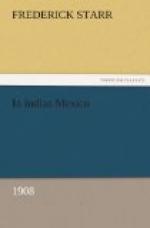Don Antonio, at whose house we stayed, told us that San Pablito is worse for bruheria than Atla. He says the people of that town make use of munecos of wood, of various sizes. For these he makes many little shoes, for which he charges five or six reales a pair; at that time he had orders for three pairs, and showed us the little forms or lasts he employs, and the special leather; they are particular about this, using black for shoes for males and red for females. He says they also use little hats, serapes, enaguas and quichiquemils, for their munecos. Some of these dolls they place on the altar in the church, and consider them as sacred, though they remove them when they expect the priest. Others they take to a lake in the district of Tenango, near San Pablo el Grande, and leave them there as offerings. They also throw money and other offerings into the lake.
We started at eight o’clock the following morning, bound for Tenango del Doria. For a little time, after leaving Pahuatlan, we mounted, soon finding ourselves at the top of a magnificent crest. From here the descent was rapid and profound; in front of it rose an equally abrupt slope to an even greater height; toward the left this presented a wonderful knife-edge crest, jagged and toothed astonishingly, and on this great slope, below the level where we were, we saw San Pablito, prettily located. As it was Sunday, most of the people were on their way to market, and we saw many Otomis, whose dark color and broad faces reminded us of those in the state of Mexico, though they did not present so marked a type. The enaguas of the women consisted of an upper white strip and a lower striped one, the colors in the latter being blue and white, or white with a broad band of purplish blue, in which were woven white designs. Their quichiquemil was usually rather plain; white with a broad band of red, magenta or purple, parallel to the edge. It might, however, be decorated with a number of very small geometrical, floral, and animal figures, worked in brown, purple and blue, which were never so crowded as to destroy the white background. At 9:30 we reached the schoolhouse and called out the teacher, to whom we delivered a letter which the presidente of Pahuatlan had given us for him. He summoned the town authorities and we made known our wish to see some of the bark paper. At first there was some hesitancy, but, at last, an old woman produced two sheets which, she said, she made the day before. At our wish she then brought out the tabla, or board of wood on which the beating is done, and the stone for beating. The latter was smaller than the ancient beating-stone, and not grooved upon the beating surfaces; it had, however, the side notches for convenient holding in the hand. The board on which the beating is done is smooth, and is constantly cleaned and soaped. Two kinds of bark are used, moral and xalama, the former giving




